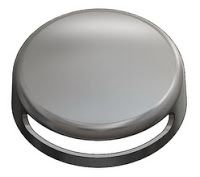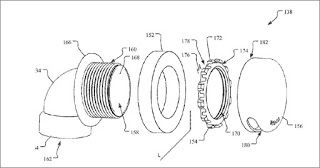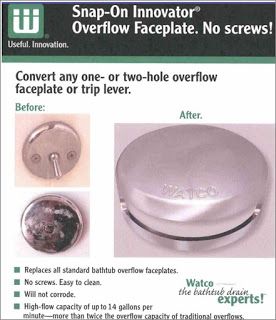Yet another product configuration "mark" failed to clear the Section 2(e)(5) hurdle, as the Board affirmed a refusal of the proposed mark shown below, finding it to be de jure functional for "Plumbing products, namely, a bathtub overflow drain cap." After a detailed review, the Board found that applicant's own utility patents were "sufficient to make the determination of functionality." It declined to reach the issues of failure-to-function under Sections 1, 2, and 45, and acquired distinctiveness under Section 2(f). [Griff Thomas reported here on the oral argument in this case]. In re WCM Industries, Inc., Serial No. 87555014 (March 17, 2020) [not precedential] (Opinion by Judge Karen Kuhlke).

In Inwood Labs., Inc. v. Ives Labs., Inc., 456 U.S. 844, 214 USPQ 1, 4 n.10 (1982)), the Supreme Court stated that a design configuration is de jure functional if it is "essential to the use or purpose of the article" or if it "affects the cost or quality of the article." In TrafFix Devices, 58 USPQ2d at 1006, the Court made it clear that if a design is functional under Inwood, there is no need to consider the existence of available alternative designs or whether there is a competitive necessity for the feature.
Applicant, in arguing for registrability, focused on "the specific shape of the opening, the smooth top, and the curvature into the perpendicular sidewalls." Reviewing applicant's patents, the Board found that "the product configuration mark results from the utilitarian snap on feature. The size of the cover is dictated by the curvature of the tub, the depth of the side walls is dictated by the requirement to be able to snap on and allow water flow but not too deep as that is aesthetically unpleasant."

Applicant argued that its utility patents protect the functional aspects of the interior of the cover, not the outward face and sidewall, which provide an aesthetically pleasing design. Moreover, it argued that the shape of the slot makes the water drain less quickly than in other configurations, and therefore the device does not work better in this shape. Applicant acknowledged the utilitarian aspect of a drainage hole [i.e., de facto functionality] in allowing overflow water to drain, but it argued that the "style of the slot is otherwise a design consideration – not a functional one." The Board was not impressed.
The overall configuration is directed by utilitarian concerns of an overflow cover that is used to cover the round overflow pipe and plate while allowing water to flow through the drainage hole. The product configuration makes the overflow cover easier to install (no screws, rounded configuration snaps on to cylindrical retainer nut) and safer (no screws so smooth rounded surface to avoid abrasion on the skin). In addition, the drainage opening encompassed by the sidewall allows for the circular overflow cover to snap onto the circular retainer nut.
The Board found that "the evidence of record, assessed in its entirety, establishes that Applicant's design is functional because it is essential to the use or purpose of the product." The Board noted that, "while the rounded ends of the drainage hole may not be 'essential' they are too incidental to transform the overall functionality of the applied-for mark into a capable mark."

For the sake of completeness, the Board went on to consider the remaining Morton-Norwich factors. Applicant's advertising was directed to "use of a 'screwless' or 'no screw' cap," but the Board found a connection between these statements and the advantage of "the cylindrical shape with sidewalls [that[ accommodates the snap on feature attaching to a circular retainer nut." As to the alternative designs that Applicant proffered, the Board was unable to discern whether these designs "achieve the snap on utility, which requires, for example, a wall of a certain depth that snaps onto a circular nut." Finally, the evidence did not support a finding "that the cost of manufacture for Applicant's goods gives Applicant a competitive advantage."
Examining Attorney Heather A. Sales suggested that the design is also aesthetically function, since Applicant asserted that its covers "snap on and off, making them easily interchangeable to match the décor of the room." The Board, however, found that "the issue of functionality relates more to utility than aesthetics. *** [I]t is the snap on utility which dictates, in part, the 'design' and allows overflow covers to be interchangeable to match décor."
And so the Board affirmed the Section 2(e)(5) refusal.
The content of this article is intended to provide a general guide to the subject matter. Specialist advice should be sought about your specific circumstances.
